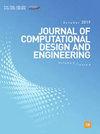A C3 continuous double circumscribed corner rounding method for five-axis linear tool path with improved kinematics performance
IF 6.1
2区 工程技术
Q1 COMPUTER SCIENCE, INTERDISCIPLINARY APPLICATIONS
引用次数: 0
Abstract
Corner rounding methods have been widely developed to pursue the smooth motions of machine tools. However, most corner rounding methods, which adopt the double inscribed transitions, still remain an inherent issue of retaining large curvatures of transition curves. Even for those double circumscribed transitions-based methods with relatively small curvatures, they also constrain excessively the transition lengths and are limited to a low-order continuity, deteriorating the feedrate and jerk of machine tools. For addressing these problems, a C3 continuous double circumscribed corner rounding (DCCR) method is proposed for five-axis linear tool path. In this method, the C3 continuous double circumscribed B-splines are specially designed to round the corners of tool position and tool orientation, whose transition lengths are analytically determined by jointly constraining the approximation errors, overlaps elimination and parameter synchronization. Moreover, the excessive constrains of transition lengths imposed by traditional methods are alleviated by fully considering the effects of overlaps and parameter synchronization, and the jerk of rotary axes is also limited with a high-order continuity. Compared to the existing double inscribed corner rounding (DICR) and DCCR methods, experiment results demonstrate that our method can improve further the feedrate while limiting the jerk of machine tools.一种改善了运动学性能的五轴直线刀具轨迹的C3连续双边界圆角方法
为了追求机床的平滑运动,圆角方法得到了广泛的发展。然而,大多数采用双内切过渡的圆角方法仍然存在保留过渡曲线大曲率的固有问题。即使对于那些曲率相对较小的基于双限定过渡的方法,它们也会过度约束过渡长度,并且仅限于低阶连续性,从而使机床的进给速度和加速度恶化。针对这些问题,提出了一种五轴直线刀具轨迹的C3连续双边界圆角法。该方法利用C3连续双限定b样条曲线对刀具位置角和刀具姿态角进行圆角处理,通过对逼近误差、消除重叠和参数同步的共同约束,解析确定其过渡长度。此外,充分考虑了重叠和参数同步的影响,减轻了传统方法对过渡长度的过度约束,并具有高阶连续性,限制了旋转轴的抖动。实验结果表明,与现有的双内圆角方法(DICR)和DCCR方法相比,该方法在限制机床抖动的同时能进一步提高进给速度。
本文章由计算机程序翻译,如有差异,请以英文原文为准。
求助全文
约1分钟内获得全文
求助全文
来源期刊

Journal of Computational Design and Engineering
Computer Science-Human-Computer Interaction
CiteScore
7.70
自引率
20.40%
发文量
125
期刊介绍:
Journal of Computational Design and Engineering is an international journal that aims to provide academia and industry with a venue for rapid publication of research papers reporting innovative computational methods and applications to achieve a major breakthrough, practical improvements, and bold new research directions within a wide range of design and engineering:
• Theory and its progress in computational advancement for design and engineering
• Development of computational framework to support large scale design and engineering
• Interaction issues among human, designed artifacts, and systems
• Knowledge-intensive technologies for intelligent and sustainable systems
• Emerging technology and convergence of technology fields presented with convincing design examples
• Educational issues for academia, practitioners, and future generation
• Proposal on new research directions as well as survey and retrospectives on mature field.
 求助内容:
求助内容: 应助结果提醒方式:
应助结果提醒方式:


